#John Larrabee
Explore tagged Tumblr posts
Text
Skyscraper (1996)
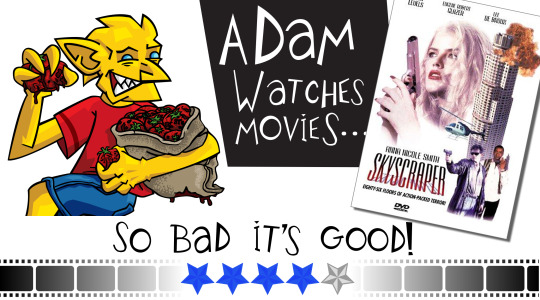
I might feel bad for the late Anna Nicole Smith - for everyone in Skyscraper - if they weren’t so terrible in the film. This inept Die Hard clone can't develop credible villains or heroes, deliver thrilling action scenes or make you forget that you’ve seen this story done time and time again. The only thing it does “well” is cram in scenes of Anna Nicole Smith taking off her clothes. The film's over-the-top softcore sensibilities are so jaw-droppingly bad it becomes a riot.
Helicopter pilot Carrie Wink (Smith) has the unfortunate luck of transporting ruthless South African criminal mastermind Fairfax (Charles M. Huber) to the Zitex building. Inside the 86-floor high-tech skyscraper is the last electronic device he needs for his master plan. His goons take over the security desk and take everyone inside hostage. While Carrie’s police officer husband, Gordon (Richard Steinmetz), pieces together what’s going on, it’s up to the lone heroine to save the day.
If you had any doubts about it, director Raymond Martino wastes no time confirming that indeed, Anna Nicole Smith was cast so she could show off her 36DD bust. As our star showers herself clean, she takes extra care to always point her chest towards the glass door. The scene is so long and gratuitous that you’re shocked when it’s followed by a prolonged sex scene with her husband. Most R-rated movies with nudity in them would require you to stop and rewind a couple of times for you to get your business over and done with. Not Skyscraper. It gets downright awkward, and the picture’s just getting started. You think this is as much of Smith in her birthday suit as we’re going to get. After all, once the plot gets started, she’s inside the titular skyscraper. It’s not like she would pause her rescue mission to take ANOTHER shower. The way the film gets her naked again is much more creative. She thinks back to the time she learned to shoot a gun (a convenient way to prove to the audience that she will be able to handle the situation). It was a romantic evening out in the country… that culminated in a lot of lovemaking on a picnic blanket. It’s embarrassing but not as uncomfortable as the third instance of nipples getting exposed: an attempted rape scene that is only there so Carrie can fumble around in a nearby drawer, grab a letter opener and stab her aggressor in the dick. Genital mutilation is the real reason for that scene because if all writers William Applegate Jr. and John Larrabee wanted was to show Smith topless again, they would’ve had her “seduce” the terrorist. Except falling prey to her “charms” wouldn’t deserve the punishment of castration so they had to get “creative”. It’s as classy as an all-nude strip club.
But enough of that. What about the rest of the movie? Well, it’s Die Hard, but bad. There’s an attempt to make Fairfax seem like a criminal mastermind who thinks of everything but since the writers are idiots, the best way they could convey this was to make him quote Shakespeare over and over. His minions are completely interchangeable. At best, you might "recognize" individuals as "the guy who always wears sunglasses" or as "the one whose plunging neckline rivals our voluptuous heroine". They’re not the least bit threatening because frankly, their plan sucks. In Die Hard, the Nakatomi Plaza was nearly deserted because it was Christmas Eve and the place was still under construction. This story takes place in broad daylight on a Saturday evening. There are so many people in the building the criminals are still trying to round up hostages an hour into the movie. Even when they manage to confront Carrie, they couldn’t shoot the broad side of a bar (to be fair, neither could she).
None of the performers could be called good and if I had to single out someone as the worst, I’d be tempted to say it’s Smith. Instead, I’m going to pick on a little kid. What’s the actor’s name? I don’t know but he’s as convincing as a $3 bill. The boy roams the building's corridors like a 2-year-old and the actor must be at least 12. However old he may be, he’s too grown-up to be as stupid as he is. When his mother is gunned down, you begin thinking about how many years of therapy he’s going to go through… but don’t worry, this movie’s got that awkward question covered in a bit of shoddy last-minute writing.
Uncomfortable attempted rape scene aside, Skyscraper offers many unintentional laughs. Everyone in front of or behind the camera is so incompetent you’ll have a gas taking potshots at nearly every aspect of this film. Even making up fake titles for it is fun. If you’re wondering, my choice would be “Die HarDD”. With Anna Nicole Smith showing off her breasts as much as she does here, it feels all too appropriate. (November 26, 2021)

#Skyscraper#movies#films#movie reviews#film reviews#Raymond Martino#William Applegate Jr.#John Larrabee#Anna Nicole Smith#Richard Steinmetz#Branko Cikatic#1996 movies#1996 films
1 note
·
View note
Text
More on Lenny Bruce and John Judnich
He began as a recording engineer during the early 1960s for folk acts such as Tim Hardin. In 1964 he designed and built the first ever portable, high-fidelity concert sound system for The Beach Boys. In 1965 he recorded Lenny Bruce's The Berkeley Concert. In 1966 he designed and installed the sound system, and engineered many live sessions, at the Whisky a Go-Go. At this time he was sharing a house in the Hollywood hills with Lenny Bruce and it was Judnich who found Bruce's body.
In 1968 he was one of the founders of Tycobrahe Sound Co., which built a second portable hi-fidelity sound system to Judnich's design for Pinnacle Productions, who were producing concerts at the Shrine Auditorium . By the late 1960s he had built the mixing board at Larrabee Studios where he engineered several sessions for John Mayall. He worked on many concert tours during the early 1970s, with bands from The Beach Boys to Frank Zappa and The Mothers of Invention, plus most of the "second English wave" bands, including Black Sabbath, Deep Purple, ELO, Faces with Rod Stewart, Jethro Tull, Procol Harum and Ten Years After.
I had seen Lenny Bruce a number of times at Canter's Deli, where he used to sit in a front booth with Phil Spector and eat knockwurst. I didn't really talk with him until we opened for him at the Fillmore West[1] in 1966. I met him in the lobby between sets and asked him to sign my draft card. He said no -- he didn't want to touch it.
At that time, Lenny lived with a guy named John Judnich. John earned his living part-time by renting PA systems to local groups. A state-of-the-art system then consisted of two Altec A-7 cabinets powered by a 200-watt amplifier, and no monitor system (they hadn't been invented yet -- the old-school audio wizards had convinced everyone that it was impossible to put a microphone that close to any speaker). Vocalists had no way to hear what they were singing -- they could only hear their voices bouncing off the back wall, from the main PA. We used Judnich's system to perform in the Shrine Exposition Hall (about five thousand seats). Anyway, John used to visit every once in a while, and it was on one of these occasions that he introduced us to "Crazy Jerry."
via Frank Zappa's autobiography
source: https://wiki.killuglyradio.com/wiki/John_Judnich
2 notes
·
View notes
Text
[Porky is roused by someone from his bed and is startled at who it is]
Porky: D-D-D-D-D-Daffy, w-w-what are you doing here?
Daffy: [in aristocratic voice] Who is this Daffy? My name is John Clifford Larrabee, architect of the Acmeridian, and I'm visiting you, in a dreeeeaam.
Porky: R-r-r-r-r-r-really, because it looks like my insane friend rented a costume and b-b-b-broke into my apartment in the middle of the night for what I wish was the f-f-first time.
Daffy: [normal voice] It's a dream, it is, stho… [assumes aristocratic voice again] Porky, do not try to save the Acmeridian.
Porky: D-D-D-D-D-Daffy, there's d-d-dynamite in the d-d-drawer, just take it and get out-
Daffy: I am not Daffy!!! [activates flickering lights]
Porky: Whoo, l-l-l-l-l-lighting change!
2 notes
·
View notes
Text

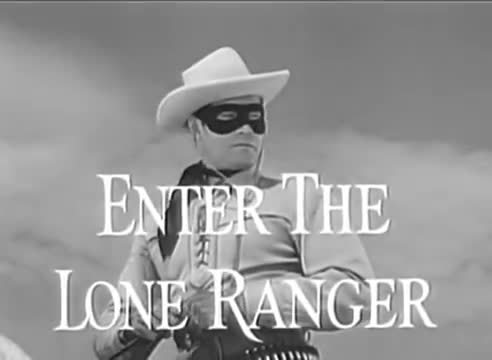
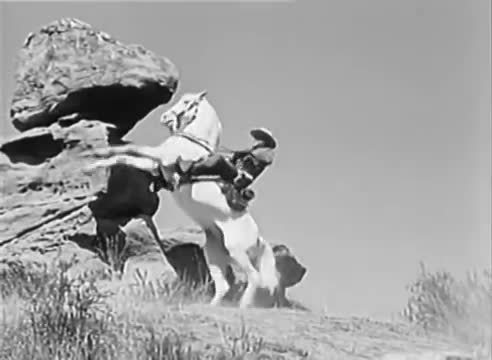
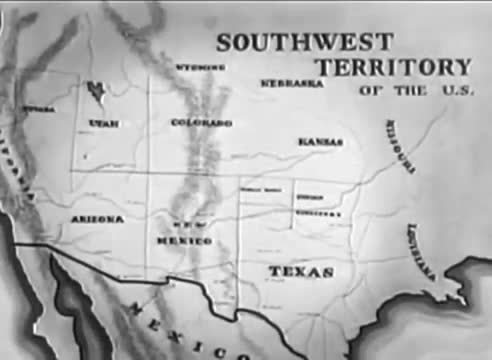

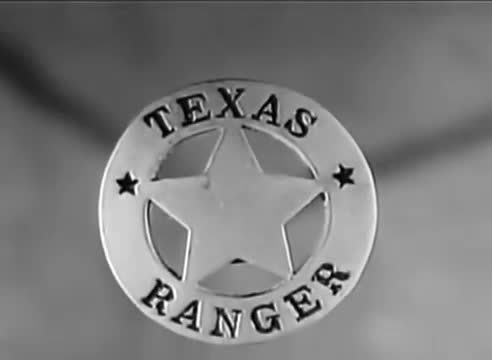



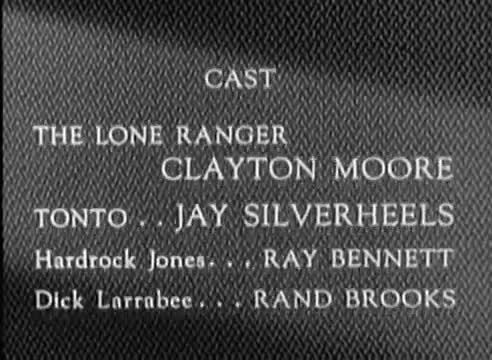
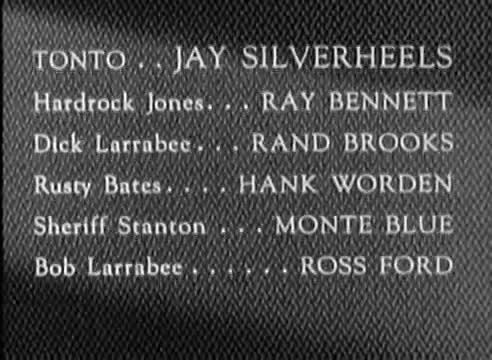
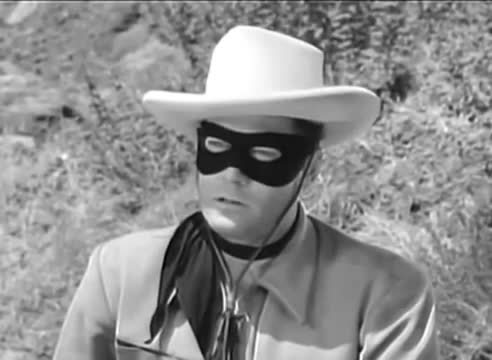
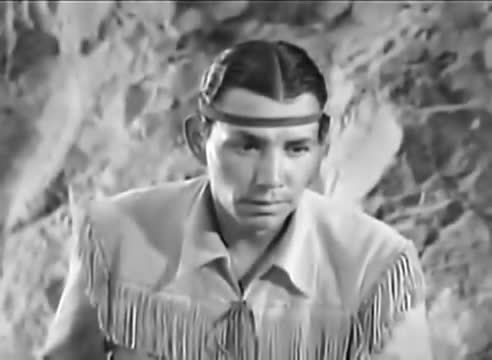
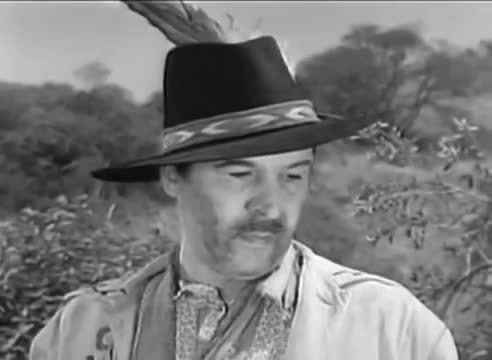
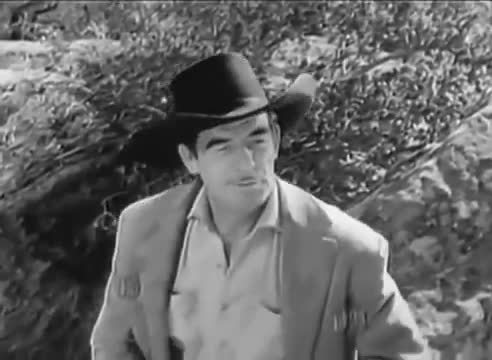
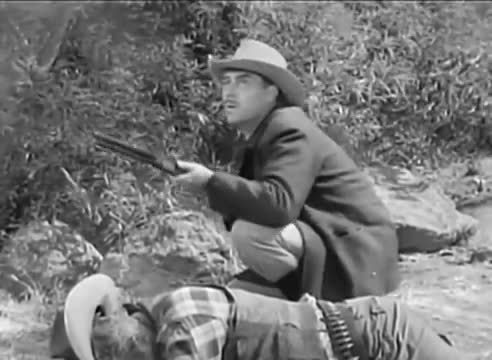

From the Golden Age of Television
Series Premiere
The Lone Ranger - Enter the Lone Ranger - ABC - September 15, 1949
Western
Running Time: 30 minutes
Produced by Jack Chertok
Directed by George B Seitz Jr.
Narrateed by Gerald Mohr
Stars:
Clayton Moore as the Lone Ranger (John Reid)
Jay Silverheels as Tonto
Glenn Strange as Butch Cavendish
George J. Lewis as Collins
Tristram Coffin as Ranger Captain Dan Reid (uncredited)
Frank Fenton as Ranger Captain (uncredited)
Jack Rube Clifford as Jerry
Ray Bennett as Hardrock Jones
Rand Brooks as Dick Larrabee
Hank Worden as Rusty Bates
Monte Blue as Sheriff Stanton
Ross Ford as Bob Larrabee
#Series Premiere#Enter the Lone Ranger#TV#The Lone Ranger#ABC#1949#Western#Clayton Moore#Jay Silverheels#Glenn Strange#George J. Lewis
4 notes
·
View notes
Text
hey!!
i am officially strep free! i feel so much better and i thank you guys for all the “get well” stuff it really helped.
sooo i am back to writing!
and since i’m back, i wanted to do a little clarifying for who i write for and what i write.
so, right now, i’m in my harrison ford era, but i haven’t seen all of his movies yet, so as of right now, his characters i write for are:
indiana jones (indiana jones duh)
han solo (star wars)
john book (witness)
tommy lillard (the frisco kid)
jack ryan (patriot games/clear and present danger)
james marshall (air force one)
rusty sabich (presumed innocent)
david holloran (hanover street)
harrison ford as himself (cause why not yk)
rick deckard (blade runner)
william jones (age of adaline)
linus larrabee (sabrina 1995)
MORE WILL BE ADDED
— — —
as for other things, i also want to start writing for:
-supernatural
-obx
-the 100
-dawson’s creek (pacey is the loml)
-marvel
-star wars (other characters besides han)
-prince eric (live action cause i love jonah)
-shadow and bone (books + show)
-actors (say there’s a specific actor whom you like and wish to read a cute lil romance about, sure why not)
and i’m sure there’s more i just can’t think of any lmao.
now as far as requests go, i will practically write anything as long as it doesn’t cross the line of yk, BAD things.
and smut. i do not write smut. i’m still somewhat young, and it makes me uncomfortable to read nonetheless write. the most you’ll get from me is a heavy make out before cutting to black.
soo yeah, that’s all. if there’s anything you want to read, you can send your request to my ask box.
i love you all sooo much, and i hope you have a wonderful day/night!
-jane 🫶🏻
#harrison ford x reader#harrison ford#harrison ford movies#indiana jones x reader#han solo#young harrison ford#star wars#indiana jones#obx#supernatural#the 100#dawson’s creek#marvel#jonah hauer king
10 notes
·
View notes
Text
Juno - Sabrina Carpenter

Introduction
"Juno" est une chanson pétillante et sincère de Sabrina Carpenter, extraite de son sixième album studio, Short n’Sweet (2024). Écrite en collaboration avec la talentueuse Amy Allen et produite par John Ryan, cette chanson capture l'âme de l'album avec une fraîcheur irrésistible. Sortie le 23 août 2024 sous le label Island Records, "Juno" prend place comme le dixième morceau de l'album, ajoutant une touche de douceur et de profondeur à ce projet vibrant.
Composition
"Juno" dure trois minutes et 43 secondes, offrant une expérience auditive riche et bien travaillée, capturée au studio Santa Ynez House dans le cadre enchanteur de Calabasas, en Californie. Le producteur John Ryan y ajoute sa touche personnelle, jouant lui-même de la batterie, de la guitare, des claviers, des percussions et de la basse, tandis que Jeff Gunnell collabore à la conception sonore. Après un travail de mastering assuré par Nathan Dantzler et Harrison Tate, le morceau prend sa forme finale avec le mixage précis de Manny Marroquin aux célèbres Larrabee Sound Studios de Los Angeles, soutenu par Zach Pereyra, Anthony Vilchis et Trey Station.
Sur le plan musical, "Juno" est une explosion pop moderne avec des inspirations rétro des années 80. Jason Lipshutz de Billboard qualifie la chanson d’« entraînement sous influence des années 80 », où Sabrina Carpenter jongle avec des jeux de mots comme "high-fived" et "objectified". La chanson construit une tension irrésistible jusqu’au pont, culminant sur une déclaration captivante : « You make me want to make you fall in love ». Jake Viswanath de Bustle y retrouve une vibe pop-rock qui rappelle le style de Sheryl Crow au début des années 2000.
Les paroles de "Juno" s'inspirent du film de 2007, explorant le désir intense de Carpenter pour quelqu'un au point d'imaginer un avenir partagé. Avec des lignes audacieuses et directes comme « make me Juno » — une référence implicite à l’envie de maternité — elle joue avec le concept de tomber amoureuse jusqu’à envisager l’héritage génétique qu’il pourrait transmettre. D'un ton espiègle, elle se complimente en déclarant : « L’un de moi est mignon, mais deux, quand même ? », flirtant avec l’idée d’une future génération.
Réception Critique
"Juno" a rapidement captivé l'attention des critiques et des auditeurs, devenant le morceau phare de Short n’Sweet selon Jason Lipshutz de Billboard, qui le place en tête des 12 titres de l'album. Il souligne que les paroles, à la fois mémorables et taillées pour TikTok et les citations sur les réseaux sociaux, sont encore plus impressionnantes grâce à la maîtrise des doubles sens de Sabrina Carpenter, mettant en lumière son expertise pop livrée avec une aisance apparente. Les auteurs de Rolling Stone ont quant à eux salué la chanson pour sa "charmante référence à la culture pop pour les âges", soulignant la profondeur de l'écriture de Carpenter, qui ne doit pas être sous-estimée.
Sam Prance de Capital a trouvé "Juno" à la fois excitante et romantique, un véritable classique pop en devenir, tandis que Carl Wilson de Slate a suggéré que ce morceau, avec "Bed Chem", était l'un des plus "excitants" de l'album. Pour Alex Hopper d'American Songwriter, "Juno" se distingue par son ton plus direct et son approche audacieuse, en comparaison avec d'autres titres de l'album qui jouent davantage sur des sous-entendus. La chanson, avec son énergie contagieuse et son côté résolument flirt, a incontestablement marqué les esprits.
Vidéos
Studio Version
youtube
Fanart

bublinko - Hobbyist, Traditional Artist | DeviantArt
1 note
·
View note
Photo

The 41-story IBM Building. 590 Madison Avenue west side between 56th to 57th streets. Edward Larrabee Barnes, John M Y Lee, Armand P Avakian, Architects.1979-1983.
View looking east of the new IBM Building from 57th Street, near Fifth Avenue Summer, 1983.
Photo: Unknown.
Source: Huxtable, Ada Louise. “The Tall Building Artistically Reconsidered: The Search for a Skyscraper Style” (New York, Pantheon Books, 1984).
#1983#1980s#IBM Building#Edward Larrabee Barnes#John M Y Lee#Armand P Avakian#midtown manhattan#posmodernism#Architecture#skyscraper#redevelopment#building boom#corporate#57th Street.#590 madison avenue
30 notes
·
View notes
Text
TSITP: Season 1 overall and Season 2 theories
First of all, as I cannot wait one year for season 2, I’m already thinking about it and writing down my theories. It’s never too soon.
Regarding season 1, the scenes that will have an importance looking forward: - (Episode 2) When Jere said that Belly is his future wife. - (Episode 2) Belly watching Sabrina (1954) and I’m pretty sure that David Larrabee is the alter ego of Conrad and Linus Larrabee is Jeremiah, because Sabrina has been in love with David all her life, such as Belly has been of Conrad. But as we all know the end, Linus leaves with Sabrina to Paris. SO, can it mean that in this version Jeremiah wins and will live with Belly until the end of his days? - (Episode 3) When Belly found condoms in Conrad’s drawer. - (Episode 4) The conversation between Jere and Steven about being exclusive as a couple. - (Episode 5) All the conversation Conrad has with Cleveland about being good with yourself first. - (Episode 6) Jere being in bed with Belly, more than Conrad. - (Episode 6) Belly being the only “innocent” girl (virgin). - (Episode 6) Jere in his room, getting ready (what’s the meaning of that)? - (Episode 6) Jere touching Belly’s breasts (and more)? - (Episode 7) Susannah agreeing to take the treatment. And of course, the amazing cast of the show.
All that leads to those theories regarding season 2: - Where season 2 will take place? In Boston? Or will they jump directly to the next summer? I honestly don’t think so. I’m pretty sure that season 2 will take place in Boston during fall and Susannah will be healed (I don’t believe that she will die right away). If it takes place in Boston, the show will become like a Gossip Girl version. Also, I honestly think that Nicole will be back (the actrice is too beautiful and good that the show runners will not delete her character in season 2). I’m pretty sure she will be dating Conrad again after founding out that his mother is sick in the last episode. Shayla will be back too. I really want some flashback when Laurel and Susannah were younger. - Laurel’s family will move to Boston? Or are they already? - Susannah will ask for a divorce. - I see a potentiel triangle love between Laurel, Cleveland and her ex-husband John. - Normally Conrad is going to college this year, one near Boston I presume? - Jeremiah will ask Belly to be exclusive (in Boston?) and she will say yes. - I’m also pretty sure that Belly will lose her virginity next season (too much hint to that - the condoms in the drawer, the only one who hasn’t done it yet, being naked under the towel in front of Jere, Jere touching Belly’s breast), but right now I’m not sure to whom. Will she lose it to Jere as his girlfriend or to Conrad being a one night thing only? I’m torn (even if I wish deep down that she will do it with Jere). - Also, I think it’s too soon for Jere to propose to Belly. It’s a tv-show, not a movie (trilogy). Did I forget something? What do you think?
#the summer i turned pretty#tsitp#tsitp season 1#tsitp season 2#review#theory#tsitp theories#conrad fisher#jeremiah fisher#conrad x nicole#belly conklin#shayla x steven#thought#thoughts#pensée#pensées#tsitp thoughts#the summer i turned pretty season 2#belly x jeremiah#belly x conrad#team jelly
50 notes
·
View notes
Note
oc characters as romantic comedies?
ivy: return to me ("heartbroken and struggling emotionally after his wife's death in a car accident, bob rueland (david duchovny) agrees to go on a blind date set up by his friend Charlie (david alan grier). though the date fizzles, sparks fly between bob and the waitress, grace (minnie driver), a recovered heart transplant patient with intimacy problems of her own. when bob discovers grace's heart came from his own organ donor wife, an unusual romance blossoms between the two.")
meredith: sabrina ("sabrina fairchild (julia ormond) is a chauffeur's daughter who grew up with the wealthy larrabee family. she always had unreciprocated feelings for david (greg kinnear), the family's younger son and playboy. but after returning from paris, sabrina has become a glamorous woman who gets david's attention. his older, work-minded brother linus (harrison ford) thinks their courtship is bad for the family business and tries to break them up -- but then he starts to fall for her too.")
diana: life partners ("a 29-year-old lawyer (gillian jacobs) and her lesbian best friend (leighton meester) experience a dramatic shift in their longtime bond after one enters a serious relationship.")
alassie: the wedding singer ("set in 1985, adam sandler plays a nice guy with a broken heart who's stuck in one of the most romantic jobs in the world, a wedding singer. he loses all hope when he is abandoned at the altar by his fiancé. he meets a young woman named julia (drew barrymore), who enlists his help to plan her wedding. he falls in love with her and must win her over before she gets married.")
ramona: under the tuscan sun ("when frances mayes (diane lane) learns her husband is cheating on her from a writer whom she gave a bad review, her life is turned upside down. in an attempt to bring her out of a deep depression, her best friend, patti (sandra oh), encourages frances to take a tour of italy. during the trip, the new divorcée impulsively decides to purchase a rural tuscan villa and struggles to start her life anew amid colorful local characters, including the handsome marcello (raoul bova).")
rhea: music and lyrics ("former music superstar alex fletcher (hugh grant) used to pack them in back in the 1980s, but now he is reduced to playing nostalgia tours and county fairs. he scores a chance at a major comeback when reigning pop diva cora corman (haley bennett) asks him to write a song for her, but he hasn't written anything in years and cannot compose lyrics anyway. noticing that sophie (drew barrymore), the plant lady, has a way with words, alex proposes that he and sophie make beautiful music together.")
cornelia: man up ("when a man (simon pegg) mistakes her for his blind date, a woman (lake bell) decides to play along to see what happens.")
kaden: my big fat greek wedding ("everyone in the portokalos family worries about toula (nia vardalos). still unmarried at 30 years old, she works at dancing zorba's, the greek restaurant owned by her parents, gus (michael constantine) and maria (lainie kazan). after taking a job at her aunt's travel agency, she falls in love with ian miller (john corbett), a teacher who is tall, handsome and definitely not greek. toula isn't sure which will be more upsetting to her father, that ian is a foreigner or that he's a vegetarian.")
andreia: wimbledon ("frustrated at his own failures and disillusioned with professional sports, tennis player peter colt (paul bettany) resolves to retire from competition and become an instructor at an exclusive private club. but when colt receives a surprise wild-card berth in wimbledon, he can't help but enter the tournament. soon, colt meets lizzie bradbury (kirsten dunst), a beautiful american tennis player with an upcoming match of her own, and finds the inspiration he hopes will turn his luck around.")
suzy: you've got mail ("struggling boutique bookseller kathleen kelly (meg ryan) hates joe fox (tom hanks), the owner of a corporate foxbooks chain store that just moved in across the street. when they meet online, however, they begin an intense and anonymous Internet romance, oblivious of each other's true identity. eventually joe learns that the enchanting woman he's involved with is actually his business rival. he must now struggle to reconcile his real-life dislike for her with the cyber love he's come to feel.")
samuel: 10 things I hate about you ("kat stratford (julia stiles) is beautiful, smart and quite abrasive to most of her fellow teens, meaning that she doesn't attract many boys. unfortunately for her younger sister, bianca (larisa oleynik), house rules say that she can't date until kat has a boyfriend, so strings are pulled to set the dour damsel up for a romance. soon kat crosses paths with handsome new arrival patrick verona (heath ledger). will kat let her guard down enough to fall for the effortlessly charming Patrick?")
bianca: 13 going on 30 ("a girl who's sick of the social strictures of junior high is transformed into a grownup overnight. In this feel-good fairy tale, teenager jenna (christa b. allen) wants a boyfriend, and when she's unable to find one, she fantasizes about being a well-adjusted adult. suddenly, her secret desire becomes a reality, and she is transformed into a 30-year-old (jennifer garner). but adulthood, with its own set of male-female challenges, isn't as easy as it looks.")
archibald: sleeping with other people ("twelve years after a one-night stand, a man (jason sudeikis) and a woman (alison brie) run into each other and try to maintain a platonic relationship despite their mutual attraction.")
raphael: bride and prejudice ("with four beautiful daughters of marrying age, manorama (nadira babbar) and chaman bakshi (anupam kher) frantically seek out the perfect husbands for their children. yet their eldest daughter, lalita (aishwarya rai), is intent upon marrying at her own choosing, for love. lalita endures a number of hopeful suitors, but the american william darcy (martin henderson) seems different -- and not always in a good way. misunderstandings, schemes and lies threaten to keep the two from true love.")
3 notes
·
View notes
Note
Salut, I was wondering if you could tell me what the books from your post about John Larrabee's library were? I may be interested in reading them. Thank you
Salut !
One is Common Sense by Tom Paine and the other is The Great Debate by Yuval Levin :)
1 note
·
View note
Photo

“My thoughts about home I have committed to Poetry- and set it to Music which I will now transcribe”
Journal as Kept by Horatio N. Haley on Board Ship N. Larrabee of Bath ME, 1857-1858, as she traveled from Bath to St. John, to Liverpool to Kingston and then to New Orleans, back to Liverpool, to Trieste and again to New Orleans. He must have been very homesick!
#age of sail adjacent#logbook#sailing#i shall have to take a crack at playing this one of these days#a local boy!
5 notes
·
View notes
Text
CMP Travel Program and Section of Invertebrate Paleontology Promotes the 125th Anniversary of the Carnegie Library of Pittsburgh with an outdoor walking tour
Before Carnegie Museums of Pittsburgh (CMP) reopened to the public on June 28th, Barbara Tucker, Director of CMP’s Travel Program, talked with me about ways to reengage members and bring them back to the Oakland museums.
With knowledge about my research on the 125th Anniversary of the founding of the Carnegie Library, Barbara suggested a 90-minute outdoor walking tour around the exterior of the massive building. Starting from where the oldest portion of the building (Portal Entry) meets the newest (Museum of Art) to the front of the historic library entrance, past the Diplodocus carnegii statue, to Forbes Avenue and the entrances of the music hall, natural history museum, and fine arts museum guarded by the statues of the noble quartet.

Fig. 1
The tour was advertised on the CMP website under the Travel Program link, https://carnegiemuseums.org/things-to-do/travel-with-us/ and https://carnegiemuseums.org/kollar/, and accurately described as an activity fully compliant with CDC protocols. Within a week, the tour received overwhelming signups, which were organized by date and number of participants by Travel Program assistant Isabel Romanowski. Three tour dates were set in August and several more in September. Special private tours for donors and others in the fall continue to be arranged.
Andrew Carnegie, Founder:
As guide for an exercise that involves close observation of architectural details, I face the challenge of getting participants to imagine this section of Pittsburgh long before any of the structures around in Oakland existed. The library and museums cover five acres of flat bottom land formed by the pre-Ice Age Monongahela River more than 1.2 million years ago. In far more recent times, the land was part of the Mary Schenley Mount Airy tract of 300 acres which was donated to the City of Pittsburgh in 1889 to create Schenley Park in her honor. Andrew Carnegie, (1835 – 1919) industrialist, steel magnate, and philanthropist, in 1895 saw the site as a place to build a complex with a library, fine arts gallery, science museum, and music hall that would represent the noble quartet of literature, art, science, and music.
The Library Tour Themes:

Fig. 2
Tour groups assemble on the dark stone steps outside the Carnegie Museum of Art (CMOA) rear entrance for an introduction focusing on the two connected, but architecturally different buildings: the Beaux-Arts style Carnegie Complex, with the original structure dating to1895, and later addition to 1907, which was built by Longfellow, Alden, and Harlow using Carnegie Steel (Fig. 2), and the modern Carnegie Museum of Art, built by architect Edward Larrabee Barnes in 1974.
Two rock types distinguish the building exteriors. The older portions of the building are clad in a light grey, easily carved, 370 million-year-old Berea Sandstone from Amherst, Ohio, while the exterior and much of the interior of Museum of Art is covered in the 295 million-year-old bluish iridescence Larvikite igneous rock from Larvik, Norway. When Barnes was commissioned to build CMOA, he chose the dark rock to blend with the older building’s coal dust veneer, a grime coating that was removed when the exterior stone was cleaned in 1990.
Landscape Art and Geology:
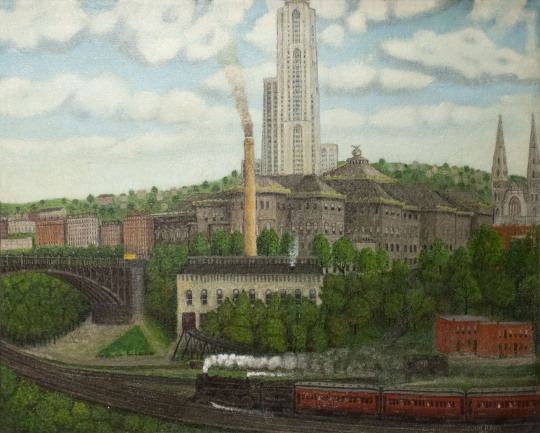
Fig. 3
Pittsburgh’s landscape painter, John Kane’s (1860 – 1934), Cathedral of Learning, circa 1930 (Fig. 3), depicts the 150-foot-deep Junction Hollow with its operating railroad. The work also includes many important architectural references, the Schenley Park Bridge (1897), Carnegie Institute’s Bellefield Boiler Plant (designed by Alden and Harlow in 1907 to supply electricity and heat to adjacent buildings), the Carnegie Institute Extension (1907), and a then unfinished Cathedral of Learning. This painting is part of CMOA Fine Arts collections.

Fig. 4
Another John Kane landscape, Panther Hollow, circa 1930 – 1934, (Fig. 4A) in combination with Cathedral of Learning has been used in teaching about the 300 million-year-old geology of Schenley Park (Fig. 4B2) and the pre-Pleistocene Monongahela River that formed the flat bottom landscape of Oakland, and through erosion, Junction Hollow (Fig. 4B1). Kollar and Brezinski 2010, Geology, Landscape, and John Kane’s Landscape Paintings.
Junction Hollow Landscape:
Kane’s Cathedral of Learning (1930) is an idealized green space of Junction Hollow, the Wilmot Street Bridge in the foreground (1907) now replaced with the Charles Anderson Bridge (1940), and Carnegie Tech’s (now Carnegie Mellon University’s) Hamerschlag Hall or Machinery Hall (1912), built by Henry Hornbostel, a Pittsburgh architect. Hornbostel designed a circular Roman temple wrapped about a tall yellow brick smokestack (Fig. 4A). The design is based on the Roman temple of Vesta in Tivoli, Italy, dating to the early 1st century BC. Hornbostel’s overall campus design focused on connection between art and science, with Junction Hollow representing the geological sciences. The architect Philip Johnston, who built Pittsburgh’s postmodern PPG Place (circa 1984), once contrasted the Bellefield Boiler Plant smokestack as “the ugliest in the world to Machinery Hall’s smokestack as the most beautiful.” In novelist Michael Chabon’s debut novel, The Mysteries of Pittsburgh, (1988) the Bellefield Boiler Plant, termed “the cloud factory” by the narrator, is the setting for a pivotal scene.
Carnegie Library of Pittsburgh (Main):

Fig. 5
The separate institutions we now know as Carnegie Museum of Natural History and Carnegie Museum of Art can track their origins to exhibits and galleries within space now fully occupied by Carnegie Library of Pittsburgh. An image of the Carnegie Library of Pittsburgh in 1902 from the Bellefield Bridge, a structure now buried under the Mary Schenley Memorial Fountain (1918), reveals eclecticism in architectural features (Fig. 5). The west facing frontage doorways and portico of the library features, CARNEGIE LIBRARY, FREE TO THE PEOPLE, and 24 carved writer names. Missing from the names is Carnegie’s favorite poet, Robert Burns, whose statue was dedicated in 1914 on the grounds of Phipps Conservancy. Three separate entrances are served by granite steps of Permian age from Vermont, one for the science museum, one for the Department of Fine Arts, and the third, with distinctive Romanesque round doorways, brass doors with intricate features, and keystone scrolling, for the Library. This entrance was designed by Harlow, who was the draftsman on the McKim, Mead, and White team responsible for the Beaux-Arts Boston Public Library (1895). When the Carnegie Institute Extension was constructed in 1907, the science museum and fine arts museum collections were moved into the new space. The former spaces in the library became the Children’s Room, Pennsylvania Room, and Music Library.

Fig. 6

Fig. 7
A challenge at this point in the tour involves discussing features that are not visible up close. The Longfellow, Alden, and Harlow’s Italian Renaissance and Beaux-Arts H-shaped parallelogram winning design featured a copula (Fig. 6) on top of the red tile roof that was never built. Eclecticism features include a double apse, a smaller shaped semi-circular extension of the library’s wall on the southside of the building, and larger apse on the north or Forbes Avenue side of the building, with the semicircular Music Hall auditorium, designed by Longfellow. The music hall exterior was structurally changed by the 1907 construction (Fig. 7).
The exterior Berea Sandstone reveals rustication masonry techniques with the cut blocks on the exterior first floor level distinguished by ashlar pillow horizontal border stone, and smooth masonry from the second floor to the cornice below the roof line. The second floor late Gothic style windows are divided by a vertical element called a mullion that helps with rigid support of the window arch and divides the window panels. Two symmetrical Campanile towers that Carnegie called “those donkey ears” were modeled after the San Marco Bell Tower in Venice, Italy. The towers served as an architectural offset to the semicircular exterior walls of the music auditorium and were removed in 1902 for the construction of the Carnegie Institute Extension. The installation of the towers can be interpreted as a tribute to Henry Hobson Richardson’s Allegheny County Courthouse twin towers (1888).
Architects choice of light grey sandstone and red tile roof:
The library’s red tile roof incorporated multiple glass roofs over the library, fine arts galleries, and science museum (all shaded from exterior sunlight today) which typified the Beau-Arts style. Keep in mind, the library did not have electric light. Light was provided by gas lighting and natural sunlight. Longfellow, Alden, and Harlow wrote that “the choice of a red tile roof and grey Ohio (Berea) Sandstone was intentional to contrast with Pittsburgh’s grey skies and the changing seasonal colors of the foliage in Schenley Park.”
The Beaux-Arts Architecture of the Carnegie Institute Extension 1907:
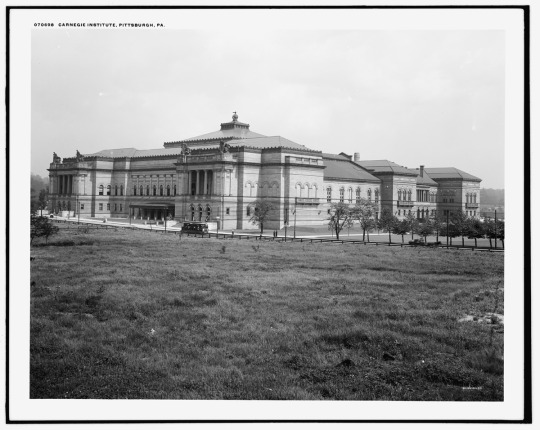
Fig. 8
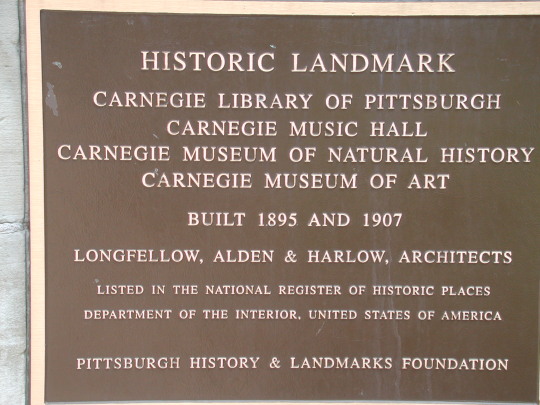
Fig. 9
After Longfellow returned to his Boston practice in 1896, Alden and Harlow received the commission to build the Carnegie Institute Extension (1907) (Fig. 8). Their efforts created one of the great Beaux-Arts building in the United States. As Cynthia Field, Smithsonian Architecture Historian, stated in 1985, “the building itself is the greatest object of the entire museum collection.” Formal recognition of the building’s architectural importance exists in two historic landmark plagues placed outside of the Carnegie Library entrance and the Museums’ Carriage Drive entrance (Fig. 9).
New exterior features of the 1907 extension work included the replacement of the red tile roof with copper, the addition of an armillary sphere, the construction, with a colonnade of solid Corinthian fluted columns of Berea Sandstone, four portico porches over the main entrances to the library, music hall, natural history and art museum, and eastside of building (now removed), and the creation, along Forbes Avenue, of a main Carriage Drive entrance with direct access to the galleries. The carved names of authors, artists, musicians, and scientists in the buildings’ entablature, a Victorian era practice, extends around the building from the library’s southeast corner to the music hall entrance, and natural history and the fine arts entrances.
Also notable along Forbes Avenue are John Massey Rhind’s noble quartet statues that guard the Music Hall and Natural History and Art entrances. The four male figures all seated in classic Greek chairs are Michelangelo (art), Shakespeare (literature), Bach (music), and Galileo (science). Standing three stories above the quartet on the edge of the roof, four groups of female allegorical figures represent literature, music, art, and science as well. The bronze figures were casted in Naples, Italy in 1907 (Fig 8).
Inside the 1907 Architecture and Building Stones:
The architects created 13 new interior spaces where three grand spaces stand out for specific architecture styles such as, the Beaux-Arts Grand Staircase (voted in 2018 as the 8th best museum staircase in the world), the Neoclassical Hall of Sculpture, and neo-Baroque Music Hall Foyer. The extension used 32 varieties of marbles and fossil limestones, many from antiquity, quarried and imported from Algeria, Croatia, France, Greece, Ireland, Italy, and the United States.
Since 2004, the collaboration between the CMP Travel Program and the Section of Invertebrate Paleontology has been highly successful reaching out to our members and patrons. This summer’s tours generated some particularly appreciative comments:
The Carnegie's resident scientists are a defining characteristic of this noble institution. Might be an anachronism in an era when museums are focused on providing 'destination' entertainment and hosting special events for swells, but while treasures like Dr. Kollar are still on staff, it’s a splendid idea to facilitate interaction between them and museum visitors. Congratulations on a most enjoyable program. -Ron Sommer
Albert was very informative and interesting. I found it most valuable learning the history of the area. -Janet Seifert
I can't stress enough how unusual and interesting it was to have a geologist give us the tour. It had never occurred to me before that there's so much one can learn about building materials from a geologist. -Neepa Majumdar
Albert D. Kollar is Collection Manager and Carnegie’s Historian of the Carnegie’s Building Stones. Barbara Tucker is Director of Carnegie Travel Program.
14 notes
·
View notes
Photo










Get Smart Again! - ABC - February 26, 1989
Comedy / Spy Spoof
Running Time: 96 minutes
Stars:
Don Adams as Maxwell Smart
Barbara Feldon as Agent 99
Bernie Kopell as Siegfried / Doctor Helmut Schmelding
Dick Gautier as Hymie
Robert Karvelas as Larrabee
King Moody as Shtarker
Harold Gould as Nicholas Demente
Kenneth Mars as Commander Drury
John De Lancie as Major Waterhouse
Steve Levitt as Beamish
David Ketchum as Agent 13
Danny Goldman as Dr. Denton
Roger Price as Hottentot
#Get Smart Again!#TV#ABC#1980's#Comedy#Spy Spoof#Don Adams#Barbara Feldon#Bernie Koppell#Dick Gautier#Robert Karvelas#King Moody#Harold Gould#Kenneth Mars#John De Lancie
2 notes
·
View notes
Text
No one asked, but here are my classic film starter recommendations!
All these films are from the 1930s to the 1960s, also known as the Golden Age of Hollywood. Removing the usual recommendations like Casablanca, Citizen Kane, Breakfast at Tiffany’s because we all know these have been cemented as faves by a lot of film nerds like myself (although I personally don’t really like Citizen Kane, but I understand why its so iconic).
1. The Thin Man (1934) - SERIOUSLY. WATCH THIS. A murder mystery + Nick and Nora Charles being relationship goals. You will fall for William Powell in this one if you didn’t fall for him in the next few recommendations I have. You will probably prefer William Powell and Myrna Loy’s pairing over the others who would be paired with them in their respective film careers. This is the first of 6 movies but those could be for a separate post if anyone’s interested.
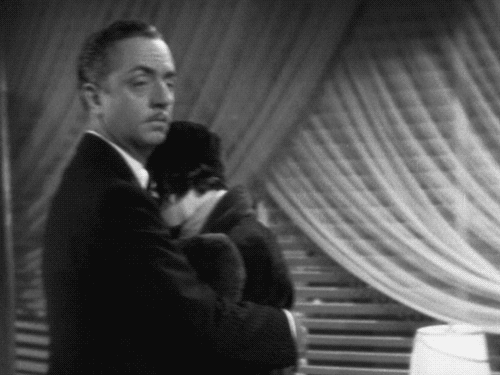
2. It Happened One Night (1934) - Clark Gable + Claudette Colbert. A screwball romantic comedy that gives me the fuzzies.
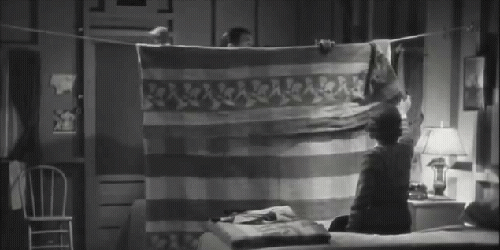
3. Double Indemnity (1944) - Barbara Stanwyck gives everyone a masterclass in acting in this noir film that really became the benchmark for many noir films to come.

4. Dinner at Eight (1933) - John and Lionel Barrymore (Drew Barrymore’s grandfather and great uncle), Billie Burke, Jean Harlow, Marie Dressler, Wallace Beery are all facing some problems in the buildup to an upcoming high society dinner.
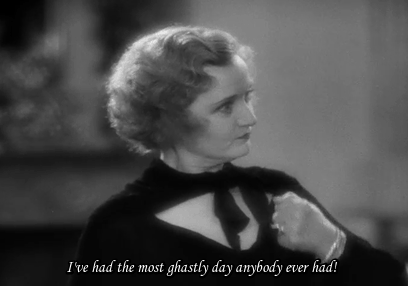
5. One Way Passage (1932) - William Powell and Kay Francis are two star-crossed lovers who meet at a cruise heading stateside. The ending isn’t as sad as you think, especially if you get around to listening to the radio adaptation.
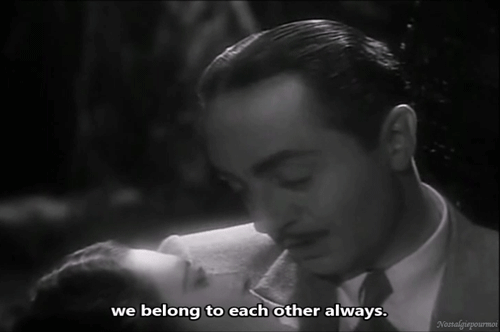
6. Sunset Blvd (1950) - Another iconic noir film, Gloria Swanson plays an aging actress from the silent era trying to recapture her heyday. It ends badly for William Holden.
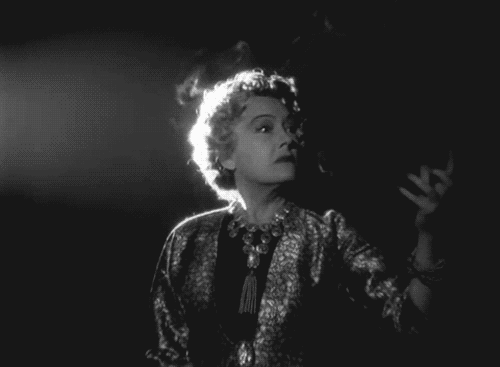
7. Mr. Blandings Builds His Dream House (1948) - The title is exactly what it is, and it’s a feel-good film. Cary Grant and Myrna Loy play this upper-class New York family who decide to move to the country and they transform a run-down estate into their dream house!

8. Pillow Talk (1959) - Doris Day and Rock Hudson! If you’ve watched Down with Love, then Pillow Talk is the movie it pays homage to (split-screens, phone conversations). Takes you back to the years where there was such a thing as a “party line” and having to get a private line was tough.

9. The Jewel Robbery (1932)- Can you tell William Powell is my favorite actor? He plays a jewel thief who comes across a baroness played by Kay Francis. He doesn’t expect that his own target would fall in love with him - but things work out for both of them in the end.

10. Sabrina (1954) - Imagine Humphrey Bogart playing a romantic lead? You will now once you watched this! Audrey Hepburn’s Sabrina is pining for William Holden’s David Larrabee, with Bogie playing his older brother Linus, who ends up falling in love with Sabrina.

4 notes
·
View notes
Text
Sparano & Mooney Architecture designs state-of-the-art buildings for Utah State University's Fine Arts Campus
As one of Utah’s leading architecture firms, Sparano & Mooney Architecture is sought after for its limitless exploration and deep commitment to the design process, which has resulted in thoughtfully innovative and award-winning contemporary design solutions within the American West.
For founders, Anne Mooney, AIA, and John Sparano, FAIA, a shared passion for designing within the rugged Western landscape have resulted in works across extreme topographies, as well as multiple sectors, most notably landmark designs for arts and cultural facilities. In celebration of their portfolio, the firm’s forthcoming monograph Sparano + Mooney Architecture, A Way of Working, published by Hatje Cantz and available in August 2022, highlights the dialogue between concept and location found in their work, as well as their commitment to sustainable and innovative buildings that are embedded harmoniously into spectacular mountain landscapes.


The firm's long-standing work at Utah State University in Logan, UT has resulted in significant expansions, renovations, and new construction of three state-of-the-art buildings for the school’s Fine Arts Campus: Sid Perkes Theatrical Design Complex, Daines Concert Hall, and the Nora Eccles Harrison Museum of Art (NEHMA). The newest building, the Art Research & Education Center at the Nora Eccles Harrison Museum of Art, is anticipated to open in 2025 and will be located adjacent to NEHMA. Though completed over many years, the work collectively shares a commitment to restrained forms and innovative material detailing that responds both to the campus’ natural surroundings and the unique relationships between each building.
Also Read | 4 ways to style your interior spaces with copper
“Our team has been honoured to collaborate with the University on the renovations and additions to their Fine Arts complex for nearly a decade,” says Anne Mooney. “We now look forward to developing a new, state-of-the-art educational facility that will allow an extraordinary collection of artworks to be accessible to researchers, faculty, students, and to the wider community.”
Nora Eccles Harrison Museum of Art (NEHMA)
The original Nora Eccles Harrison Museum of Art (NEHMA) building was designed by American architect Edward Larrabee Barnes and completed in 1982 as an expansion of the larger Fine Arts Center on the campus of Utah State University (USU). Sparano + Mooney Architecture’s design of the museum’s new addition is a quietly restrained form that does not compete with nor mimic the existing museum nor the adjacent signature building, a 2006 Sasaki-designed Performing Arts Center. Rather the addition creates a new public plaza that connects the two buildings in a neutral response to a visually complex context.
[dd:gallery id=750]
Daines Concert Hall
The Newel and Jean Daines Concert Hall project includes the complete renovation of the former Kent Concert Hall to create a new state-of-the-art space for orchestra, band, and choral programs. The renovation includes a new acoustical shell; acoustically reconfigured walls and finishes; and upgraded theatrical, audio, and lighting equipment to enhance the acoustic performance of the venue for both performers and audiences. The new concert hall serves audiences throughout the region with world-class music and programming in a newly renovated and state-of-the-art cultural facility.
Also Read: Easy Guide To Choose A Color Palette For Your Space
Sid Perkes Theatrical Design Complex
Part of the Utah State University Department of Theatre Arts and the Caine College of the Arts, this project includes the expansion and renovation of the existing Scene and Costume Shops, which support the Morgan Theatre and other local theatrical venues. The new 8,000-square-foot addition by Sparano + Mooney Architecture provides the necessary tooling, layout, equipment, and storage space for the design and construction of theatrical scenery, including a new paint booth and dust evacuation system. The upper level of the facility provides new work and teaching space for theatrical costume production, including new sewing stations, layout and work tables, fabric storage, fitting rooms, a dye vat, laundry facilities, and faculty offices.
Art Research & Education Center at NEHMA
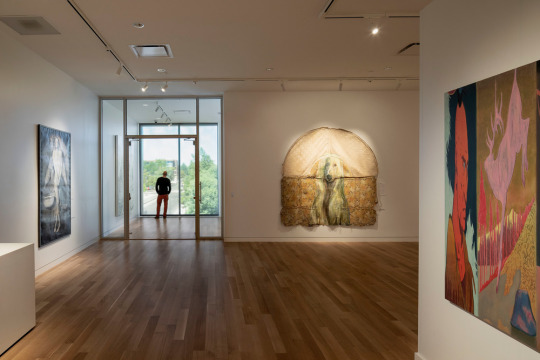

Visitors will also be able to see how the museum cares for and stores objects will allow them to search the database, and open drawers to engage with and learn about art in a more personal, explorative way.
Also Read | Montreal, Canada : New outdoor furniture section on degaspe.ca
Read More
0 notes